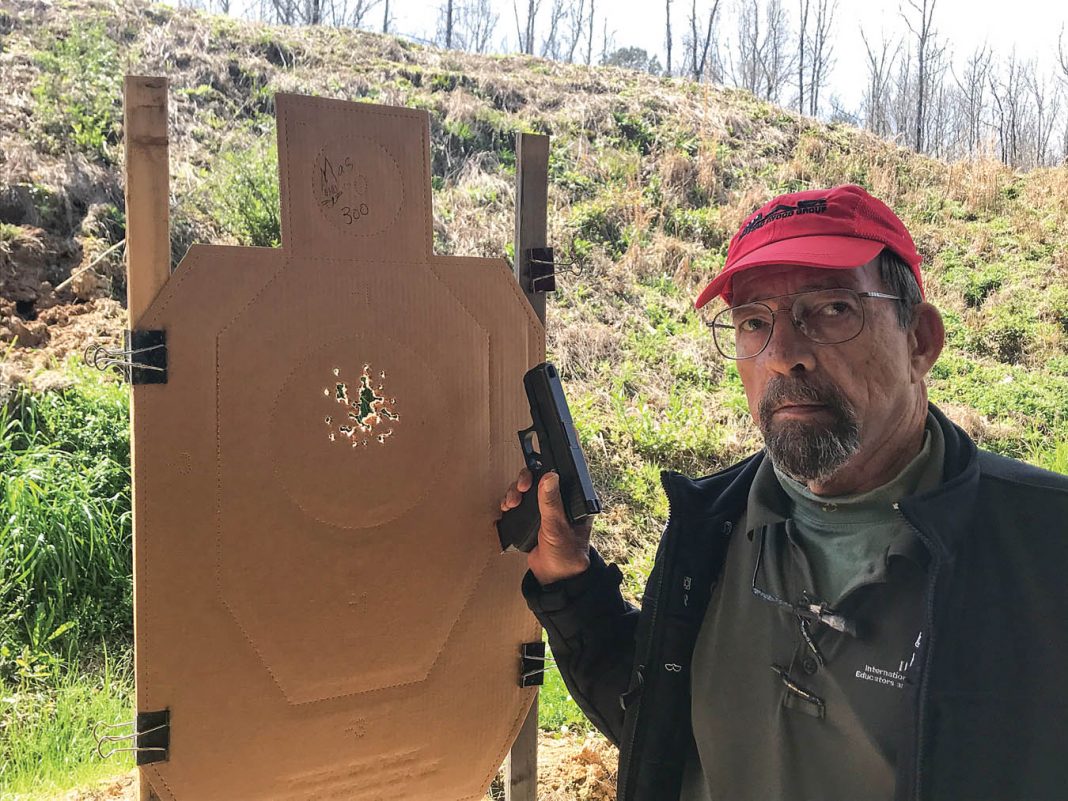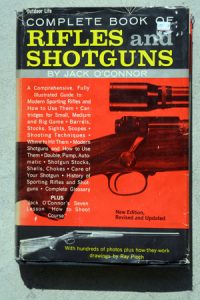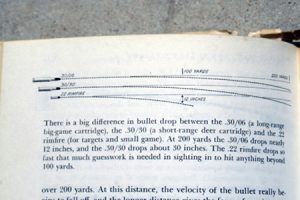Reader Dennis writes:
Mas,
I am trying to explain to my wife why the line of sight of a gun and the line of travel of the bullet are not the same thing. I have searched for a diagram on the internet but haven’t found anything. Do you have something? To her, a picture would be worth a thousand words.
Dennis
Dennis, nobody ever explained it better than that great old rifleman Jack O’Connor. The pictures below are from his classic “Complete Book of Rifles and Shotguns,” published by Outdoor Life and Harper & Row 50 years ago. The principle hasn’t changed in the last half century.
Basically, the bullet leaves the muzzle trying to go in a straight line, but gravity acts upon it and pulls it down in a slow curve. The shooter compensates for that by adjusting the sights to send the bullet out going slightly upward. Thus, its path describes a gentle curve in which – in effect, from the shooter’s perspective – it goes upward and then downward, crossing the exact point of aim once on the way up and then again going down as the now apparently curving trajectory crosses the straight line of sight.
O’Connor explained it better, and illustrated it, below. Thanks for caring about giving your wife solid explanations, and for giving me a chance to pay homage to a great gun writer on the 50th anniversary of one of his best works.
O’Connor’s classic.
O’Connor explains line of sight vis-a-vis line of bore.
O’Connor elaborates on bullet drop.
Practical trajectory from hunter’s eye view.







Mas! I love you.
Back when I was 10 years old, a friend gave me a copy of this book. I thought it was the best book on rifles and shotguns that I had ever read. I read it constantly, and learned something new from its pages each time.
I lent it to a friend, who moved away and lost it. About the same time, I also forgot the title. I’ve been searching for this book for about 30 years, and suddenly discovered it here.
Thanks to this post, I can now find a copy online.
Please know that the efforts to share your knowledge and experience are greatly appreciated.
Rog
Thanks so much for this blast from the past!
FYI. There are a whole pile of used copies of these on Amazon for less than $10. Steal.
Dennis could also use a pass in football (or anything where something is thrown). The QB throws the ball *up*, so that gravity will pull it back down to where the receiver is (or is supposed to be–an example of leading the target).
Kind of you to explain it for him Mas, but I don’t think he tried very hard to find anything on the net. Googling “shooting trajectory” brings up multiple examples.
It’s all about the ballistics….. with varying degrees depending upon the launching system.
Gotta love it.
For a practical demonstration of projectile ballistics, go play paintball. It’s like combining old school artillery with handheld projectile launchers. Which is why most players don’t sight their paintball markers along top the gun in a straight line but down the side and holding it up and angled slightly high for longer range shots. We do that to better observe the ball as it arcs down range.
True, this is different than firearms, but the principle is the same, if exaggerated due to greater drag through the air (the paintball IS a .68, 3 gram, liquid filled, slightly-out-of-round, seamed musket ball) being launched at a low ballistic velocity (generally 300fps at most).
Pretty simple concept, but hard for people new to shooting to grasp. another is how to move your sights to get correct shot placement. O’Connor was one of the best. And yes kudos to Dennis for caring to help his wife understand. Reminds me of Diann (sp) at Cedar Rapids who went from none shooter to Qualifying in a couple of days because enough people cared. Aren’t shooters great? Well most anyway.
Mas:
You’re trying to explain this in a nation where a high percentage of college freshmen can’t understand sixth-grade math!
You guys are all a bunch of shooting geeks. The best way to explain trajectory is to go into the back yard, get the garden hose, put it on as tight a stream of water as possible and use that to explain line of sight, trajectory & leading a target (kids are good for this demo on hot days).
Good for Dennis for teaching his wife about guns. Mine told me to write her a book and she’d read it. I’m 25,000 words in and not even close to being done *toothy smile*
@Matt- I lol’ed at your comment. It’s 100% true. I got out of college a few years ago, did some part-time IT work. Saw quite a few Computer Science or Computer Engineers who struggled with turning on their PC…
Forgive the bad gun analogy but higher education has because more ISPC than IDPA. Too many students focus on gamesmanship and getting the grade rather than studying (or learning to think critically….but I digress). Heck, I’ve gotten a B with a 37%…there’s something to think about next time you see your doctor.
Lots of good examples of trajectory. Its good to hear Mr. O’Connor’s book is still available at Amazon. I remember reading it but don’t have a copy. That problem will be remedied. Amazing that my dad, from Mr. O’Connor’s generation, could take out squirrels with an open sighted .22 short as far as he could see them using only experience.
@Tim from CO…You overestimate the math skills of most high school graduates. Some how or other they pass math but can’t apply it to anything practical. (I attempt to teach HS Chemistry.) There is an add below this to “build your own chicken coop” that would be an insurmountable obstacle for most of my students except those taking vo-ag of course.
Years ago, when we first got together, my wife asked me to teach her to shoot. Starting with a 10/22 and a box or two of ammo and a few targets we began. After a considerable time(and lots of ammo) my wife was still rather befuddled over it all. In sheer fustration I went to the gun cabinet and came back and said “dear this is a shotgun don’t worry about the sights”. Anyhow she didn’t kill me on the spot and we married a year later.